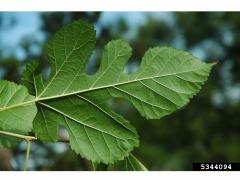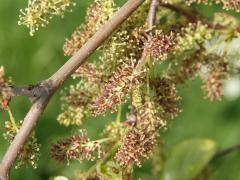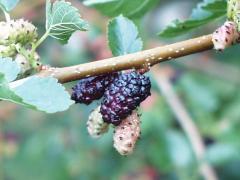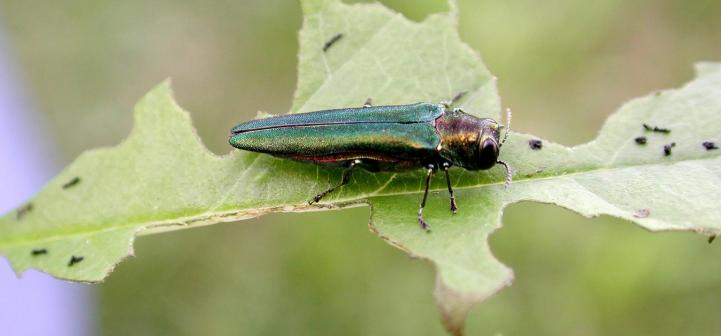Invasive Species: Morus alba, White Mulberry
White mulberry is a small, 30 to 50 ft. (9.1 to 15.2 m) tall, deciduous tree that invades disturbed areas throughout the United States. The alternate leaves are polymorphic (variably shaped), 2 to 8 in. (5.1 to 20.3 cm) long, and shiny with blunt teeth and heart-shaped bases. Young bark, the bark along the roots, and the inner bark along the trunk are often bright orange. Older bark is gray with narrow, irregular fissures. Flowering occurs in April. Plants are normally dioecious (male and female flowers on separate plants). Male flowers are small and green and occur in 1 to 2 in. (2.5 to 5.1 cm) long catkins. Female flowers are inconspicuous and crowded in short spikes. The tree has multiple fruit that is a little longer but that otherwise looks very similar to a blackberry. Colors range from white to pink, then red to purple as it matures. The fruit is eaten and dispersed by birds and other wildlife. White mulberry is very similar to the native red mulberry (Morus rubra L.) but may be distinguished by the leaves. White mulberry leaves have glossy surfaces, whereas the leaves of red mulberry do not. White mulberry is found throughout the United States, where it invades old fields, urban lots, roadsides, forest edges, and other disturbed areas. It poses an ecological threat by displacing native species, possibly hybridizing with and transmitting a root disease to the native red mulberry. White mulberry is native to Asia and was introduced in colonial times as a food source for silkworms.
What are invasive species and why should we be concerned about them?
Taxonomy: Scientific and Common Names for This Species
Urticales > Moraceae > Morus alba L.
Synonym(s): mulberry
Morus alba – USDA PLANTS Profile
Distribution Maps
White mulberry – The reported distribution of this invasive species across the United States. (Source: Invasive Plant Atlas of the United States)
Up-to-the-minute distribution maps and why they are important
Reporting This Invasive Species
What is the best way and place to report the occurrence of an invasive species?
How to report an invasive species sighting to EDDMapS – Early Detection & Distribution Mapping System
EDDMapS – Report an invasive species to EDDMapS
Cooperative Extension Offices – Find your local Cooperative Extension office on this map provided by USDA
How to Identify
This invasive species can be identified by looking for the characteristics described in the paragraphs that follow.
Tree
A small, 30 to 50 ft. (9.1 to 15.2 m) tall, deciduous tree that invades disturbed areas throughout the United States.
|
|
 |
| Robert Vidéki, Doronicum Kft., bugwood.org | Chuck Bargeron, University of Georgia, bugwood.org |
Foliage
The alternate leaves are polymorphic (variably shaped), 2 to 8 in. (5.1 to 20.3 cm) long, and shiny with blunt teeth and heart-shaped bases.
 |
 |
| David J. Moorhead, University of Georgia, bugwood.org | David J. Moorhead, University of Georgia, bugwood.org |
Flower
Flowering occurs in April. Plants are normally dioecious (male and female flowers on separate plants). Male flowers are small and green and occur in 1 to 2 in. (2.5 to 5.1 cm) long catkins. Female flowers are inconspicuous and crowded in short spikes.
 |
 |
| Robert Vidéki, Doronicum Kft., bugwood.org | Robert Vidéki, Doronicum Kft., bugwood.org |
Fruit
The tree has multiple fruit that is a little longer but that otherwise looks very similar to a blackberry. Colors range from white to pink, then red to purple as it matures. The fruit is eaten and dispersed by birds and other wildlife.
 |
 |
| Chris Evans, River to River CWMA, bugwood.org | Ohio State Weed Lab Archive, The Ohio State University, bugwood.org |
Native Species That Resemble White Mulberry
Morus rubra, red mulberry – Images at invasive.org
 |
 |
| Rebekah D. Wallace, University of Georgia, bugwood.org | Paul Wray, Iowa State University, bugwood.org |
– Images at invasive.org
| bugwood.org | bugwood.org |
Additional Images for White Mulberry
White mulberry – Images at Invasive.org
Learning Resources for White Mulberry
Additional Information, Biology, Control and Management Resources
Control and management recommendations vary according to individual circumstances. Location, habitat, weather, and a variety of other conditions are factors that help determine the best treatment choice. To find the safest and most effective treatment for your situation, consult your state’s land-grant institution. If you will use chemicals as part of the control process, always refer to the product label.
United States Land-Grant University System – Find your land-grant university’s College of Agriculture, Cooperative Extension Service, or other related partner on this map provided by USDA.
Plant Invaders of Mid-Atlantic Natural Areas – National Park Service and U.S. Fish and Wildlife Service
Weed of the Week – USDA Forest Service
Morus alba – Connecticut Invasive Plant Working Group
Fact Sheet – Department of Forest Resources and Environmental Conservation
Jepson Herbarium – University of California

